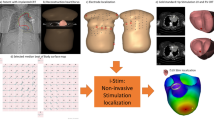Abstract
Introduction This study aimed to identify the optimal locations in multichannel magnetocardiography (MCG) and body surface potential mapping (BSPM) to detect exercise-induced myocardial ischemia. Methods We studied 17 healthy controls and 24 coronary artery disease (CAD) patients with stenosis in one of the main coronary artery branches: left anterior descending (LAD) in 11 patients, right (RCA) in 7 patients, and left circumflex (LCX) in 6 patients. MCG and BSPM signals were recorded during a supine bicycle stress test. The capability of a recording location to separate the groups was quantified by subtracting the mean signal amplitude of the normal group from that of the patient group during the ST segment and at the T-wave apex, and dividing the resulting amplitude difference by the corresponding standard deviation within all subjects. Results In MCG the optimal location for ST depression was at the right inferior grid for the RCA, at the mid-inferior grid for the LCX, and in the middle of these locations for the LAD subgroup (mean ST amplitudes: CAD −80 ± 360fT, controls 610 ± 660fT; p < 0.001). In BSPM it was on the left upper anterior thorax for the LAD, left lower anterior thorax for the RCA, and on the lower back for the LCX subgroup (mean ST amplitudes: CAD −39 ± 61 μV and controls 38 ± 38 μV; p < 0.001). In MCG the optimal site for T-wave amplitude decrease was the same as the one for the ST depression. In BSPM it was on the middle front for the LAD, on the back for the LCX and on the left abdominal area for the RCA group. In accordance with electromagnetic theory, the largest ST segment and T-wave amplitude changes took place in MCG in locations orthogonal to those in BSPM. Conclusion This study identified magnetocardiographic and BSPM recording locations which are sensitive for detecting transient myocardial ischemia by evaluation of the ST segment as well as the T-wave. These locations strongly depend on ischemic regions and are outside the conventional 12-lead ECG recording sites.
Similar content being viewed by others
Author information
Authors and Affiliations
Additional information
Received: 9 October 2000 / Returned for revision: 23 October 2000 / Revision received: 2 January 2001 / Accepted: 19 January 2001
Rights and permissions
About this article
Cite this article
Hänninen, H., Takala, P., Mäkijärvi, M. et al. Recording locations in multichannel magnetocardiography and body surface potential mapping sensitive for regional exercise-induced myocardial ischemia. Basic Res Cardiol 96, 405–414 (2001). https://doi.org/10.1007/s003950170049
Issue Date:
DOI: https://doi.org/10.1007/s003950170049




